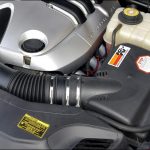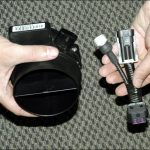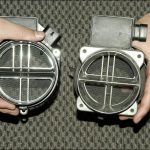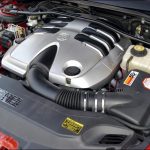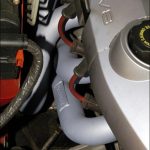We test the Bob Romano Performance Motors power-up kit for LS1s… Words by Michael Knowling, Pix by Julian Edgar
[separator headline=”h3″ title=”At last it’s happend”]
With so many people keen to modify their LS1-powered Holdens, one Brisbane workshop – Bob Romano Performance Motors – is offering a power-up kit at a reasonable price. No need to mix and match individual aftermarket products that may or may not work – you simply pay around AUD$4000 and drive away with 20 – 27 percent more grunt. There are no annoying exhaust drones, no engine mapping glitches and nothing that’ll require the car to return for future development.
It’s exactly what the market has been waiting for.
The Bob Romano Performance Motors (BRPM) LS1 kit focuses on three areas of performance – the air intake, headers/exhaust and engine management. Let’s have a look at each…
Air Intake
The BRPM air intake uses an elegant mix of aftermarket and OE components.
The standard Holden airbox is kept under the bonnet but Romano’s custom modify the lower section to incorporate a large-dimeter cold air feed. The only other non-genuine part is the fitment of a K&N washable panel filter.
In VTII – VY LS1s, the standard airflow meter is upgraded with the unit used in the current VZ series. So what’s the advantage of the VZ ‘meter? Well, with an internal diameter of 94mm, it offers a massive 21 percent greater cross-sectional area over previous airflow meters.
The VZ airflow meter is installed in earlier LS1s using a small adapter loom, which is made by Bob Romano Performance. The adapter loom is necessary to accommodate the VZ airflow meter’s different plug and integrated intake air temperature sensor. (In early LS1s, the intake air temperature sensor can be found in the airbox or the pipe between the airflow meter and throttle.)
Fitment of the VZ airflow meter to early LS1s also requires a larger diameter pipe between the ‘meter and throttle body. The BRPM upgrade uses an off-the-shelf VZ throttle body pipe which, as seen in the top of this photo, maintains a far greater cross-sectional area along its length. The VZ airflow meter also offers less intrusive pipe fittings to achieve a further gain in airflow.
Why Not Get Rid of the Airflow Meter?
About now you may be wondering why the BRPM kit comes with an airflow meter upgrade – wouldn’t it be better to switch to a restriction-free MAP sensor system?
Chris Romano explains that the airflow meter gives much better tuning flexibility (which is important if you later decide to fit a bigger cam) and maintains more consistent mixtures at all load/rpm combinations. It also avoids the flat-spots that are found in some MAP sensor tunes.
Flow restriction using the VZ airflow meter is not a major concern in most tweaked LS1s. BRPM has a customer car which runs a VZ airflow meter and is comfortable making 400hp (around 300kW) at the wheels. Put simply, restriction shouldn’t be a problem unless you’re chasing monster power.
Headers/Exhaust
The BRPM power-up kit breathes through a pair of Pacemaker Tri-Y headers, which – after countless back-to-back tests with other products – offer the best combination of top-end power and all-round torque.
From the back of the collectors, BRPM installs a custom twin 2 ½ inch mandrel exhaust. Interestingly, the standard cat converters are kept on VTII to VY LS1s – but it’s a different story for current VZs. The VZ comes from the factory with close-coupled cat converters which we’re told are much more restrictive than earlier cats. The kit replaces these with aftermarket stainless steel 2 ½ inch cats, which are mounted further downstream (in the same position as earlier models). VZ models also require an extension loom for the oxygen sensors – these are necessary because the Pacemaker Tri-Y headers relocate the oxygen sensors further away from the engine than standard.
The BRPM 2 ½ inch exhaust employs an X-pipe, twin centre mufflers and a rear muffler. The three mufflers (and twin cat converters) keep tailpipe noise suppressed but, if required, the rear muffler can be deleted. This achieves a small power gain.
Engine Management
With the air intake, header and exhaust mods fitted, BRPM custom tunes each vehicle using VCM Suite. VCM Suite gives the tuner access to re-flash the standard Holden ECU – no need for add-on electronic modules or any additional wiring.
In most instances, the Romano kitted LS1s are tuned for use with 98 RON fuel – but a lower octane tune can be specified if desired. Chris Romano describes the tune as very safe – the full-load air-fuel ratios are conservative and ignition timing is set so that the knock sensors are used to protect the engine in the event of excess heat or a bad batch of fuel (rather than using them to constantly pull-back an aggressive timing map).
Any additional necessary software changes (such as altered auto trans shift points or compensation for altered diff gears) can also be performed at this time.
Results
So what’ll your LS1 make with a BRPM power-up?
Well, figures vary depending on factory spec, transmission type, diff ratio and other factors but Chris Romano says most VX to VY Holden LS1s push out about 245hp (183kW) at the wheels in standard form (as measured on a Dyno Dynamics chassis dyno). But be aware there is a lot of power variation across different models. An early VTII LS1 can make as little as 220hp (164kW) at the wheels while a current VZ can make up to 255hp (190kW) at the wheels.
With the BRPM power-up kit fitted, an average VX – VZ LS1 is boosted to 295 – 310hp (220 – 231kW) at the wheels – a gain of around 20 – 27 percent. An early VTII LS1 typically lags slightly behind due to its more restrictive intake manifold.
If you’re prepared to put up with the extra noise, Chris says deleting the rear muffler can give up to around 315hp (235kW) at the treads – not far off his claim that around 325 – 330hp (242 – 246kW) ATW is the most you’ll see from an internally stock and un-boosted LS1.
We test drove the Romano development ute – a Holden VY SS 6-speed – and came away very impressed with the package’s performance, tractability, hiccup-free operation and refinement.
Compared to a standard LS1, the kitted car offers much improved throttle response and pulls noticeably better through the mid-range. Top-end breathing is dramatically improved and outright acceleration feels almost up with a 300kW C4B HSV. Torque delivery is smooth, you can trundle along at around 1000 rpm in top gear without any stutters, and it starts like a stocker. The exhaust system has definite attitude but at no time is it excessively noisy or offensive.
We were unable to test fuel consumption, but Chris Romano says his ute has picked up around 150km extra range – in a combination of urban/highway conditions he can now drive just over 550km on a single tank. This seems quite credible given the extra tractability that allows you to drive in a taller gear than you otherwise could.
And now let’s talk cost.
If you own a VTII – VY LS1, the BRPM power-up will set you back a reasonable AUD$4160. Alternatively, you can save AUD$575 if you leave out the airflow meter upgrade which is worth about 5 – 10hp (4 – 7kW) at the wheels.
The owners of current VZ LS1s already benefit from the big-bore airflow meter so there’s nothing for them to spend in this area. On the other hand, the VZ needs upgraded cat converters which cost AUD$400. The all-up cost for a VZ LS1 is AUD$3985.
So what’s our verdict?
Simple. If you want to tweak your LS1 with a tried-and-proven package that won’t give any hassles, there’s nothing else to rival the BRPM kit. It does everything you could ask of a modestly priced power-up package.
Contact:
Bob Romano Performance Motors (BRPM) +61 7 3395 8255
www.bobromano.com.au
- An affordable LS1 power-up kit
- Air intake, headers/exhaust and engine management mods
- A typical 20 – 27 percent power gain together with improved fuel economy
- An attractive package
[/accordion-item] [/accordion]
[fb_button]

